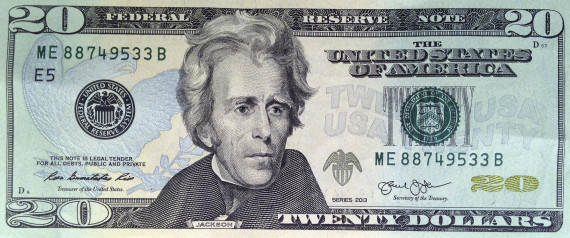
Despite a movement to replace President Andrew Jackson with a woman on the $20 bill, it appears the slave-owning Indian killer is here to stay for now. Treasury Secretary Jack Lew announced this week that Alexander Hamilton -- the architect of the first national bank and a critic of slavery -- will make way for, or at least share the $10 spotlight with, a woman in 2020.
Both Hamilton and Jackson have recently been subjects of off-Broadway shows at The Public Theater in New York. This year, Hamilton was the titular character of a hip-hop musical that portrayed him favorably as a common man, revolutionary and martyr. Jackson was portrayed in the 2011 musical “Bloody Bloody Andrew Jackson” as a maverick, murderer and thief.
That pop-culture portrayal of the seventh president has deep roots in the legacy of violence, Indian removal and enslavement that Jackson left this country.
In 1804, Jackson, then a major general in the Tennessee militia, posted a notice in the newspaper offering $50 for the return of a runaway slave named Tom Gid and "ten dollars extra, for every hundred lashes any person will give him, to the amount of three hundred."
Two years later, Jackson challenged Charles Dickinson to a duel after Dickinson called Jackson's wife, Rachel, a bigamist and accused him of cheating on a horse racing bet. In the duel, Dickinson fired first, striking Jackson in the chest. Jackson’s gun misfired, and according to the rules of dueling, upheld among the slave owners, the score was settled.
But Jackson re-cocked his weapon and fired again, killing Dickinson. In the eyes of his contemporaries, Jackson had broken the code of the duel and committed nothing less than murder.
It would not be the last time “Old Hickory” broke the law and used violence to get what he wanted.
During the War of 1812, Jackson led a bloody campaign against the Red Stick faction of the Creek Nation, who were allied with the British. After defeating the Red Sticks, he forced the entire Creek Nation -- including his Lower Creek allies -- to sign a treaty ceding 23 million acres of Creek land in present-day Georgia and Alabama to the United States.
After conquering the Creeks, Jackson became a national hero for defeating the British at the Battle of New Orleans in 1815. His victory came after the signing of a peace treaty, news of which reached the U.S. following the battle. Jackson's triumph helped propel him to the presidency 13 years later.
After the war, Jackson returned to the business of killing and taking land from Indians and expanding the institution of slavery. In 1817, he interpreted an order to subdue the Seminole -- a community of Red Sticks, Miccosukees and runaway slaves living along the border of Florida -- as an invitation to invade the Spanish-controlled territory. Unable to defeat the Seminole, who continued to resist conquest throughout the 19th century, Jackson burned their houses and crops. Then he turned his attention to the Spanish colonists and essentially claimed Florida for the United States. Along the way, he executed two British nationals for helping the Indians -- aninternational controversy at the time.
A decade later, then-President Jackson signed into law the Indian Removal Act of 1830, which enabled the violent dispossession of Indian Nations from their lands in order to expand black slavery in the Deep South.
The Indians resisted this legislation, and in 1832 the Cherokee won a Supreme Court decision protecting some of their rights as a sovereign nation. Jackson is said to have scoffed at the court's decision, declaring of the chief justice, “John Marshall has made his decision. Now let him enforce it!”
By 1837, Jackson’s administration had removed 46,000 citizens of the Choctaw, Cherokee, Seminole, Creek and Chickasaw nations from their homelands and forced them to march one thousand miles on the Trail of Tears to the so-called Indian Territory west of the Mississippi. An estimated 4,000 Cherokee, as well as untold numbers of the Indians' black slaves, died along the way. When choosing who among the forced migrants would receive meager rations along the journey, U.S. military personnel had to decide whether the slaves counted as humans deserving of basic necessities like blankets and food, or property deserving of nothing.
The death march of indigenous and enslaved peoples typified the violent progress of American slavery and settlement as it swept across the continent.
A portrait of the man most singularly responsible for this suffering has been printed on every bloody $20 bill in circulation since 1928.
The Slave-Owning, Indian-Killing History Of The Man On The $20 Bill
I refuse to carry $20 bills because of this evil bastard.

